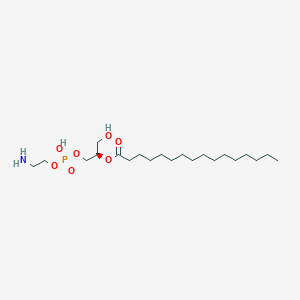| General Information of MET (ID: META00604) |
| Name |
LysoPE(0:0/16:0)
|
| Synonyms |
Click to Show/Hide Synonyms of This Metabolite
1-Hydroxy-2-hexadecanoyl-sn-glycero-3-phosphoethanolamine; 1-Hydroxy-2-palmitoyl-sn-glycero-3-phosphoethanolamine; 2-Palmitoyl-gpe; 2-Palmitoyl-sn-glycero-3-phosphoethanolamine; 2-Palmitoylglycerophosphoethanolamine; Hexadecanoyl-lysophosphatidylethanolamine; LPE(0:0/16:0); LPE(16:0); Lyso-pe(0:0/16:0); Lyso-pe(16:0); LysoPE(0:0/16:0); LysoPE(16:0); Lysophosphatidylethanolamine(0:0/16:0); Lysophosphatidylethanolamine(16:0); PE(0:0/16:0); Phosphatidylethanolamine (0:0/16:0)
|
| Source |
Endogenous;Glycerophospholipids;Food
|
| Structure Type |
Glycerophosphoethanolamines (Click to Show/Hide the Complete Structure Type Hierarchy)
Lipids and lipid-like molecules
Glycerophospholipids
Glycerophosphoethanolamines
|
| PubChem CID |
|
| HMDB ID |
|
| Formula |
C21H44NO7P
|
| Structure |
<iframe style="width: 300px; height: 300px;" frameborder="0" src="https://embed.molview.org/v1/?mode=balls&cid=53480922"></iframe>
|
 |
|
3D MOL is unavailable
|
2D MOL
|
|
Click to Show/Hide the Molecular/Functional Data (External Links/Property/Function) of This Metabolite
|
| ChEBI ID |
|
| FooDB ID |
|
| ChemSpider ID |
|
| Physicochemical Properties |
Molecular Weight |
453.5 |
Topological Polar Surface Area |
128 |
| XlogP |
2.4 |
Complexity |
451 |
| Heavy Atom Count |
30 |
Rotatable Bond Count |
23 |
| Hydrogen Bond Donor Count |
3 |
Hydrogen Bond Acceptor Count |
8 |
| Function |
LysoPE(0:0/16:0) is a lysophosphatidylethanolamine or a lysophospholipid. The term 'lysophospholipid' (LPL) refers to any phospholipid that is missing one of its two O-acyl chains. Thus, LPLs have a free alcohol in either the sn-1 or sn-2 position. The prefix 'lyso-' comes from the fact that lysophospholipids were originally found to be hemolytic however it is now used to refer generally to phospholipids missing an acyl chain. LPLs are usually the result of phospholipase A-type enzymatic activity on regular phospholipids such as phosphatidylcholine or phosphatidic acid, although they can also be generated by the acylation of glycerophospholipids or the phosphorylation of monoacylglycerols. Some LPLs serve important signaling functions such as lysophosphatidic acid. Lysophosphatidylethanolamines (LPEs) can function as plant growth regulators with several diverse uses. (LPEs) are approved for outdoor agricultural use to accelerate ripening and improve the quality of fresh produce. They are also approved for indoor use to preserve stored crops and commercial cut flowers. As a breakdown product of phosphatidylethanolamine (PE), LPE is present in cells of all organisms.
|
|
Regulatory Network
|
|
|
|
|
|
|
|
|
 click to show the details of this protein
click to show the details of this protein
 click to show the details of experiment for validating this pair
click to show the details of experiment for validating this pair

